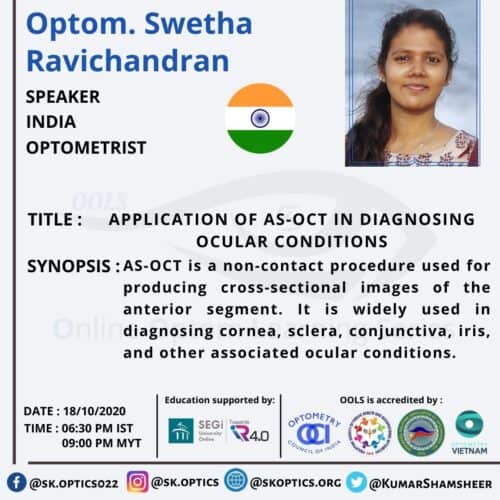
Sweta Ravichandran, a practicing optometrist and an anterior segment expert begins with introducing the Optical Coherence Tomographgy (OCT) and explaining how an OCT works, its principle and types.
- Time domain OCT
- Spectral Domain OCT
- Swept-source OCT
- Ultra high resolution OCT
We learn about the different imaging modes available for the AS-OCT and how a normal anterior segment OCT appears. We also learn the differences between the ultrasound biomicroscopy and OCT. Then we look at examples of how certain conditions will appear on the AS-OCT
- Corneal Diagnostics
- Corneal scar
- Fuch’s dystrophy
- Corneal grafts
- Deep anterior lamellar keratoplasty
- Descemets stripping endothelial keratoplasty
- Descemet membrane detachment
- Graft host rejection
- Descemet membrane folds and corneal bullae
- Interstitial space
- Intrastromal corneal ring segments
- Acute corneal hydrops
- Ulcer
- LASIK flap
- Boston Type 1 Keratoprosthesis
- Implantable Collamer Lens
- Phakic IOL
- Adherent Leukoma
- Ocular surface squamous neoplasia
- Salzmann nodular degeneration
- Conjunctival diagnostics
- Pterygium
- Melanoma
- Conjunctival Lymphoma
- Modified Osteo-Odonto-Keratoprosthesis
- Glaucoma Diagnostics
- Open and closed angles
- Open Angle – Different AC depth
- Closed Angle
- Pupillary block – narrow angle
- Plateau iris configuration
- Peripheral iridotomy
- Bleb
- Ahmed glaucoma Valve
After showing all the conditions, we conclude that though AS-OCT is an excellent techniques for diagnosis it isn’t a stand alone method. We can also use AS-OCT for dry eyes and various other ocular conditions.The session ends with a Q and A session for the live audience.
References
Papers
Development of Optical coherehce tomography
Huang D, Swanson EA, Lin CP, et al. Optical coherence tomography. Science. 1991;254(5035):1178-1181
https://www.ncbi.nlm.nih.gov/pmc/articles/PMC4638169/
Nanji AA, Sayyad FE, Galor A, Dubovy S, Karp CL. High-Resolution Optical Coherence Tomography as an Adjunctive Tool in the Diagnosis of Corneal and Conjunctival Pathology. Ocul Surf. 2015 Jul;13(3):226-35.
https://pubmed.ncbi.nlm.nih.gov/26045235/
Lim LS, Aung HT, Aung T, Tan DT. Corneal imaging with anterior segment optical coherence tomography for lamellar keratoplasty procedures. Am J Ophthalmol. 2008 Jan;145(1):81-90.
https://pubmed.ncbi.nlm.nih.gov/18028862/
Han SB, Liu YC, Noriega KM, Mehta JS. Applications of Anterior Segment Optical Coherence Tomography in Cornea and Ocular Surface Diseases. J Ophthalmol. 2016;2016:4971572.
https://pubmed.ncbi.nlm.nih.gov/27721988/
Filipe HP, Carvalho M, da Luz Freitas M, Correa ZM. Ultrasound biomicroscopy and anterior segment optical coherence tomography in the diagnosis and management of glaucoma. Vision Pan-America, The Pan-American Journal of Ophthalmology April 2016.
https://journals.sfu.ca/paao/index.php/journal/article/view/313
Lim SH. Clinical applications of anterior segment optical coherence tomography. J Ophthalmol. 2015;2015:605729.
https://pubmed.ncbi.nlm.nih.gov/25821589/
Lin J, Wang Z, Chung C, Xu J, Dai M, Huang J. Dynamic changes of anterior segment in patients with different stages of primary angle-closure in both eyes and normal subjects. PLoS One. 2017 May 18;12(5):e0177769.
https://pubmed.ncbi.nlm.nih.gov/28542344/
Kaluzny BJ, Szkulmowska A, Szkulmowski M, Bajraszewski T, Kowalczyk A, Wojtkowski M. Fuchs’ endothelial dystrophy in 830-nm spectral domain optical coherence tomography. Ophthalmic Surg Lasers Imaging. 2009 Mar-Apr;40(2):198-200.
https://pubmed.ncbi.nlm.nih.gov/19320314/
Kang JJ, Allemann N, Vajaranant TS, de la Cruz J, Cortina MS. Anterior segment optical coherence tomography for the quantitative evaluation of the anterior segment following Boston keratoprosthesis. PLoS One. 2013 Aug 5;8(8):e70673.
